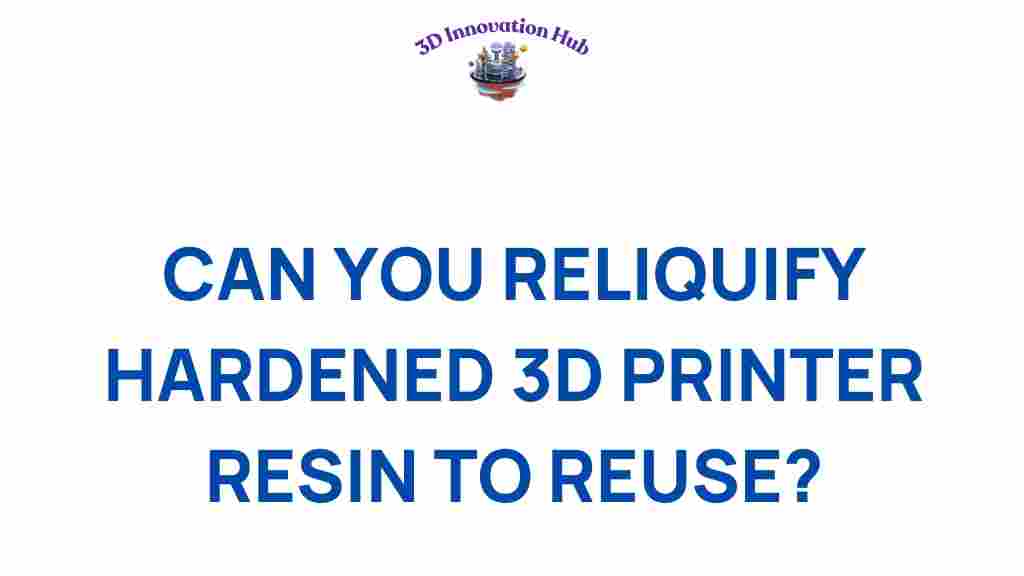Unlocking the Secrets: Can You Reliquify Hardened 3D Printer Resin?
In the ever-evolving landscape of additive manufacturing, the use of 3D printer resin has become increasingly popular among hobbyists and professionals alike. However, one common issue faced by users is the problem of hardened or cured resin. This article explores the fascinating topic of whether and how you can reliquify hardened 3D printer resin, focusing on the importance of recycling and sustainability in the world of 3D printing.
Understanding 3D Printer Resin
3D printer resin is a liquid photopolymer used in stereolithography (SLA) and digital light processing (DLP) 3D printing technologies. These resins are cured by UV light, transforming them from liquid to solid form during the printing process. While this allows for precise and detailed prints, it also leads to the challenge of dealing with leftover or improperly cured resin.
The Importance of Recycling and Sustainability
As the world increasingly prioritizes sustainability, the idea of recycling materials in additive manufacturing has garnered attention. Reliquifying hardened 3D printer resin not only reduces waste but also promotes an eco-friendly approach to 3D printing. By finding ways to reuse or recycle this material, we contribute to a more sustainable future.
Can You Reliquify Hardened 3D Printer Resin?
The short answer is yes, but it requires careful consideration and specific methods. Reliquifying 3D printer resin involves breaking down the cured polymer chains, which can be challenging. However, with the right techniques, users can effectively restore the resin to a usable state.
Step-by-Step Process to Reliquify Hardened 3D Printer Resin
Here’s a detailed guide on how to attempt to reliquify hardened 3D printer resin.
- Assess the Resin: Before proceeding, evaluate the type of resin you have. Some resins are more flexible than others and may be more susceptible to reliquification.
- Gather Materials: You will need:
- Gloves for protection
- A glass or metal container
- Isopropyl alcohol (IPA) or a similar solvent
- A stirring stick
- Soak the Cured Resin: Pour a small amount of isopropyl alcohol into the container and add the hardened resin. The alcohol will help break down the cured resin.
- Stir Gently: Use the stirring stick to mix the resin and alcohol. Be gentle to avoid creating bubbles.
- Let it Sit: Allow the mixture to sit for a few hours. This will give the solvent time to penetrate and break down the hardened resin.
- Check Consistency: After a few hours, check the consistency of the mixture. If it’s still too thick, add more alcohol and stir again.
- Filter the Mixture: Once you achieve a desirable consistency, filter the mixture to remove any solid particles. A fine mesh strainer or coffee filter works well.
- Store Properly: Store the reliquified resin in a dark, airtight container to prevent it from curing again when exposed to light.
Troubleshooting Tips
While the process of reliquifying 3D printer resin can be successful, there may be challenges. Here are some troubleshooting tips:
- Too Thick: If the resin remains too thick after soaking, try using a higher concentration of isopropyl alcohol or let it soak for a longer period.
- Not Curing Properly: If the reliquified resin does not cure correctly, it may have been too contaminated or improperly mixed. Always filter out solid particles before use.
- Unpleasant Odor: If you notice a strong smell, ensure you are working in a well-ventilated area and using appropriate safety gear.
- Discoloration: If the resin changes color during the process, it may not be usable. Always assess the final appearance before using it for prints.
Eco-Friendly Innovations in 3D Printer Resin Technology
The field of 3D printer resin technology is constantly innovating, focusing on sustainability and eco-friendly practices. Here are some noteworthy advancements:
- Bio-based Resins: Some manufacturers are developing resins derived from renewable resources, reducing reliance on petroleum-based materials.
- Recyclable Resins: New formulations allow for easier recycling and reuse of unused resin, promoting a circular economy.
- Low-VOC Options: Innovations in resin chemistry are leading to products with lower volatile organic compound emissions, making them safer for users and the environment.
- Improved Curing Techniques: Advances in UV curing technology facilitate more efficient hardening processes, minimizing waste and maximizing material use.
Conclusion
In conclusion, the ability to reliquify hardened 3D printer resin is a valuable skill for both hobbyists and professionals. By understanding the process and embracing sustainable practices, we can reduce waste in additive manufacturing and promote an eco-friendly approach to 3D printing.
As technology continues to evolve, it’s essential to stay informed about innovations in materials and recycling. By doing so, we can contribute to a more sustainable future in the world of 3D printing.
For more information on sustainable practices in 3D printing, visit this resource page. To learn more about different types of 3D printer resin, check out this detailed guide.
This article is in the category and created by 3D Innovation Hub Team
